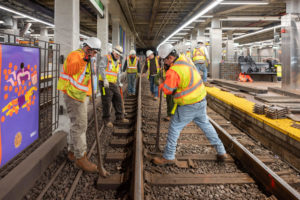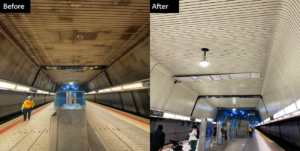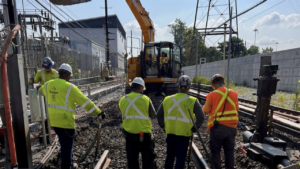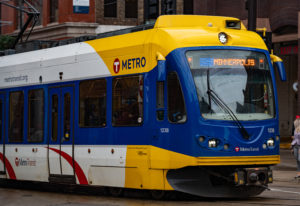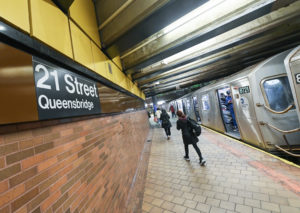Rail milling comes to North America
Written by Bob Tuzik, contributor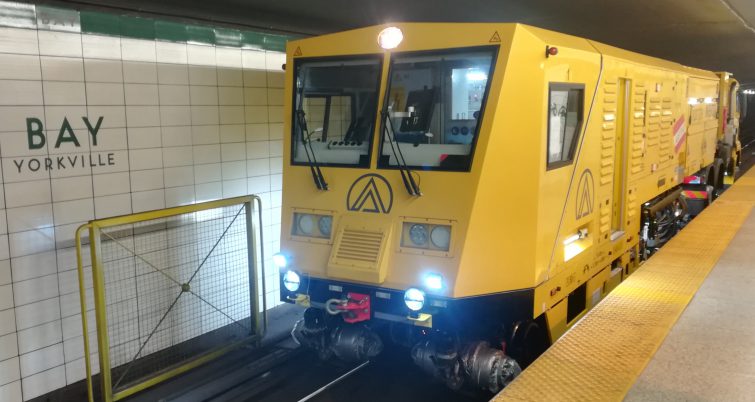
There has been talk for years about if and when rail milling technology would be coming to America. Well, the talking is over. A milling machine, the product of a joint venture between two Austrian companies, landed on these shores and began work in December of last year at the Toronto Transit Commission (TTC).
The deployment, the culmination of several years of speculation and planning, is the start of a three-year service contract to address rail shape and surface conditions in the heavy rail TTC subway lines. The joint venture, formed by LINMAG, a global provider of rail milling services and Rhomberg Sersa, which provides rail grinding, ballast undercutting and project management services (in North America), will operate as Rhomberg Sersa North America.
In order to meet requirements to commence milling work in 2018, Rhomberg Sersa leased a SF02W-FS hi-rail milling machine from Austrian manufacturer LINSINGER. The diesel-hydraulic hi-rail unit, which has one cutting head per rail, will be used to complete the first year of the contract. Rhomberg Sersa North America purchased a higher-capacity diesel-electric railbound machine (SF02T-FS) that will be built by LINSINGER and delivered later this year to fulfill the subsequent years of the TTC contract. The SF02T-FS, which will be able to remove as little as 0.1mm and as much as 1.5mm of metal from the top of rail in one pass, will provide extended chip storage capacity that will enable the machine to work continuously for up to 6 hours at a maximum processing speed of 840 meters per hour. The machine will also be equipped with state-of-the-art measurement technology to provide electronic documentation of metal removal, profiles (transversal and longitudinal), and crack conditions on the rail surface.
Milling work in year one of the TTC contract will focus on damage removal and profile restoration on portions of the Line 2 Bloor-Danforth heavy rail subway line. “We are focusing on areas that have not been ground over the past few years—areas where there is surface damage, such as corrugation or RCF, and areas in which we are too far from the target profiles,” said Mostafa Nouri, Sr. Engineer, Noise and Vibration – Maintenance Engineering for TTC’s subway lines.
“The machine is quiet, there are no sparks, there’s not much dust, and there’s not much smoke” —Mostafa Nouri
The TTC, which has used contract grinding services for the past 10 years, elected to incorporate milling into its rail maintenance programs after observing spark- and smoke-free milling operations in Europe. Like most transit systems, the TTC is sensitive to any whiff of smoke. The TTC sometimes encountered service delays addressing reports of smoke or potential fires from the traveling public on the mornings after grinding. With milling, there’s only light grinding with a fine polishing stone following the milling operation; with no sparks, there is no smoke or fire (or related passenger complaints) to deal with. Impressions after the first half dozen shifts in December are favorable. “The machine is quiet, there are no sparks, there’s not much dust, and there’s not much smoke,” Nouri said.
Nor is there much heat. LINSINGER has observed low rail temperatures during milling under test conditions. “Since the rail has such a large volume, the heat is taken directly from the surface, leaving it warm to the touch right after milling,” said Richard Stock, Milling Technology Manager at LINSINGER.
The first year of the TTC’s milling program essentially replaces what a corrective grinding program would do to remove surface damage and restore the desired profile. The TTC worked with the National Research Council of Canada to reduce the number of target profiles from five used in its grinding program to two for the milling program. Unlike grinding machines which can change the orientation of the grinding stones to generate multiple rail profiles, each cutting head on a milling machine produces only one, albeit very precise, profile; multiple profiles require multiple cutting heads. And since changing cutting heads during milling operations takes time out of the TTC’s scant 60- to 90-minute nightly work window, the TTC opted to use only two profiles for milling on the system—one biased toward the center and one biased toward the field side of the rail—regardless of the degree of curvature.
The milling work is being done in a one-pass operation. “TTC requires an average metal removal of 0.8mm of metal per pass at the top of rail, allowing about 450m of finished track per hour with the SF02W-FS hi-rail milling machine,” Stock said. The cutting head can accommodate both the 100- or 115-pound rail sections found in the TTC subways.
While it was not one of TTC’s requirements, the very smooth surface finish that milling leaves on the rail is a welcome byproduct. Expectations are that surface finish will become more important and will work its way into specifications on rail transit systems in the coming years.
The TTC’s three-year contract includes 60 milling shifts per year. The program is designed to obtain the highest potential production during the initial stages. Beginning next year, TTC expects to direct milling efforts to corrective work. It will also incorporate a traditional grinding program to address localized areas with corrugation, which drives noise- and vibration-related complaints.
Working with milling equipment will be a learning experience, TTC’s Mostafa Nouri said. “It took us a decade to really understand rail grinding; we’re starting anew with milling.”
For more on rail milling, check out the February print issue of Railway Track and Structures.

